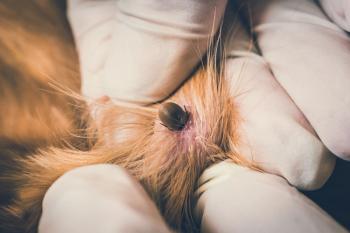
Evaluating the array of insulin products for companion animals
Owner convenience has taken preference historically over tight glycemic control.
Q. Please review insulin products for use in dogs and cats.
A. Dr. Anthony Abrams-Ogg, at the 2007 American College of Veterinary Internal Medicine Forum in Seattle, lectured on "Chemistry and Pharmacology of Therapeutic Insulin Preparations." Some relevant points from the lecture are provided here:
Therapeutic insulin products (insulins) appeared shortly after insulin's discovery in 1921. Since then, there has been continued extensive research into the chemistry of insulin and the improvement of therapeutic formulations. The marketed insulins represent only a small fraction of laboratory preparations, but even so the variety (and changes in variety) can be confusing. The key to understanding them is to understand their pharmacokinetics.
Structure and action
Mammalian insulin is a protein consisting of a 21-amino-acid A chain and 30-amino-acid B chain, folded into a tertiary structure, with some amino-acid variations between species. Within seconds of insulin binding to the insulin receptor on fat and muscle cells, autophosphorylation occurs and complex signal transduction results in a dramatic increase in cell permeability to glucose, due to translocation of the GLUT 4 glucose-transport protein from the cytosol to the cell membrane.
The exact functional surface of insulin's tertiary structure is not known, but the differences in amino-acid structure of beef, pork and human insulin are not important with respect to receptor-binding affinity. Unless there are antibodies interfering with receptor binding, human, beef and pork insulin appear to be of equivalent potency at the receptor level in humans, and are likely so in dogs and cats as well.
Pharmacokinetics
Insulins follow typical pharmacokinetics involving drug liberation, absorption, distribution, metabolism and excretion. The difference between the different products is due to liberation and absorption. Insulin is secreted physiologically as a monomer (single molecule) and needs to be in that form to be metabolically active. In pharmaceutical products, insulin is present in complex forms. Insulin is absorbed in the subcutaneous space into the blood predominantly as monomers and dimers, and the different products liberate insulin monomers and dimers at various rates. Once insulin is absorbed, the product of origin is irrelevant. Furthermore, while different physiologic and pathologic states may affect distribution, metabolism and excretion, these effects are not as important on insulin's glycemic effects as are those affecting absorption.
Insulins are, therefore, classified as short, intermediate and long-acting, based on their rate of absorption. Compared to more slowly absorbed insulin, more rapidly absorbed insulin will have an earlier glycemic effect. For any given quantity of insulin, if the insulin is more rapidly absorbed, then blood insulin concentration will be higher; hence, the more rapid-acting insulins are more potent.
Because the pharmacokinetics after absorption are the same for the different insulins, a more rapidly absorbed insulin will leave the circulation sooner with respect to injection time. In addition, more rapid-acting insulins are more consistently and completely absorbed, resulting in a more predictable glycemic effect.
Traditional intermediate and long-acting insulins are suspensions of precipitated insulin. Dissolution of a precipitate is an unpredictable process, and probably is affected by different physiologic states, which accounts for some of the variability in absorption and less-consistent response than that seen with insulin solutions (e.g., regular insulin). There also is a dose effect on pharmacokinetics, in that a larger insulin dose will result in a higher, later peak, and longer duration of action.
Short-acting insulins
Regular insulin is an insulin-zinc solution. When injected intravenously, the insulin concentration is rapidly diluted. After intramuscular or subcutaneous injection, the concentration is lowered by diffusion into tissues and the insulin dissociates more slowly, accounting for the longer onset and duration of action and reduced potency, as compared to the same dose given intravenously. Even as a solution, insulin is not completely absorbed when injected subcutaneously, with bioavailability of 65 percent in dogs and 45 percent in cats.
Semilente insulin is an insulin-zinc suspension of amorphous (non-crystalline) zinc-insulin precipitate. After subcutaneous injection, the amorphous particles undergo dissolution, releasing insulin monomers. The liberation of insulin is slower than in regular insulin, but more rapid than intermediate-acting insulins. Semilente insulin is available only as a component of Lente insulin.
Insulin lispro is a human insulin analogue made by reversing the order of B28 proline and B29 lysine of human insulin. Insulin aspart is made by substituting aspartic acid for proline at B28. These substitutions reduce insulin self-association so the insulin remains monomeric/dimeric and, therefore, is absorbed twice as quickly after subcutaneous injection as regular insulin.
Receptor binding affinity is similar to human insulin. Because of the rapid onset of action and lack of precipitation, these insulins are currently the products of choice for prandial injection (to control post-prandial hyperglycemia) by injection and in insulin pumps. A major advantage of these insulins in humans is allowing a flexibility in diet, as post-prandial hyperglycemia may be addressed. They have no advantage over regular insulin for intravenous use. Pre-clinical studies have been performed on dogs and cats, mostly as toxicity studies, but acceleration of absorption may not be as pronounced.
Regular insulin is used primarily in veterinary medicine in treatment of diabetic ketoacidosis, and occasionally to treat post-prandial hyperglycemia in dogs. Owner convenience has taken preference historically over tight glycemic control.
Once-daily injection has been preferred, with a gradual shift toward twice-daily injection, and the duration of regular insulin is too short for such a purpose. Given that it is easy to control diet in dogs, that post-prandial hyperglycemia is mild and prolonged in cats, that regular insulin is unlikely to be withdrawn, and that these analogues may not be faster-acting in dogs, they are unlikely to be extensively used.
Intermediate and long-acting insulins
Neutral protamine Hagedorn (NPH) insulin and protamine-zinc insulin (PZI) are suspensions of protamine-zinc-insulin crystals at a neutral pH. Protamine, a fish protein usually of salmon or trout origin, acts as the retarding agent. It is presumed that subcutaneous proteolytic activity cleaves the protamine from the insulin, resulting in crystal dissociation and release of insulin monomers. A small amount of zinc is present as a stabilizing agent that prolongs the action by inhibiting protaminases.
In NPH insulin, insulin and protamine are present in at a 1:5 ratio. A small amount of phenol/cresol is also required. In PZI, the protamine and zinc are present in excess, which further prolongs the action. PZI for human use was discontinued in 1991. A 90 percent beef/10 percent pork insulin (PZI-VET, IDEXX) for use in cats is now available in the United States. Pure beef PZI for cats is also available from some compounding pharmacies.
The stimulus to produce beef PZI is the perception that it is a superior insulin to use in cats because: 1) beef insulin is structurally the closest to cat insulin; 2) the duration of action of insulins in cats compared to humans and dogs is short; therefore a long-acting insulin is desirable; and 3) PZI is more completely and consistently absorbed than Ultralente insulin.
Concerning insulin structure, beef, pork, and human insulin probably all bind with similar affinity to the insulin receptor of the cat. The only concern with different insulin structure would, therefore, be one of immunogenicity, which does not appear to be an important problem in cats.
Cats are unpredictable in their response to insulin, although the reason for this is not understood. Compared to dogs and humans, insulin in cats is less completely absorbed, and perhaps this is at least in part responsible for the observation that duration of insulins in cats is short.
It has been proposed that the short duration is the result of a counter-regulatory phenomenon. In a study of normal cats measuring insulin concentration and blood glucose following administration of 1 U/kg, mean (range) peak insulin concentration was 763 (262-2758) pmol/L for beef/pork PZI vs. 318 (126-804) pmol/L for beef-pork Ultralente insulin. Mean (range) peak insulin concentration over baseline was reached in four (one to 12) hours for beef/pork PZI vs. eight (two to 20) hours for beef-pork Ultralente. Mean (range) duration of increase in insulin was 24 (22-24) hours for beef/pork PZI vs. 21 (14-24) hours for beef/pork Ultralente. Mean (range) blood-glucose nadirs were achieved at eight (three to 20) hours for beef/pork PZI vs. 10 (five to 24) hours for beef/pork Ultralente. Degree of blood glucose reduction was similar.
In addition to demonstrating the highly variable absorption kinetics, these results suggest that beef/pork PZI is more completely absorbed than Ultralente. Although the initial recommendation was to use beef/pork PZI once daily, resulting in acceptable glycemic control in some cats, the current recommendation is to give it twice daily.
Beef/pork PZI is not recommended as initial treatment in dogs because intermediate-acting insulins have an adequate duration of action in dogs, and intermediate-acting insulins have more consistent absorption.
Beef insulins also are more immunogenic in dogs, and antibody formation has resulted in inconsistent absorption and action.
Some cats have had adequate glycemic control with beef/pork and human NPH insulin given twice daily, but in other cats the duration of action is too short. Currently only human NPH is available. The main advantage of NPH insulin over beef/pork PZI is that, as expected, the former has greater and more consistent absorption.
NPH insulin has been a mainstay of the treatment of diabetes mellitus in dogs for years, with a shift from beef/pork to human because of product availability. Once-daily administration was the initial approach, but there is cumulating evidence that twice-daily administration results in more acceptable glycemic control.
Ultralente insulin is an insulin-zinc suspension of crystalline zinc-insulin precipitate. The crystals are more stable than the amorphous zinc-insulin precipitate of Semilente; therefore, monomers are more slowly released in the subcutaneous space.
As with PZI, beef insulin-zinc crystals are more stable than pork and human insulin-zinc crystals. Prior to its discontinuation, beef Ultralente insulin had the longest duration of action in humans and was considered a peakless insulin, similar to insulin glargine. Human Ultralente insulin also was discontinued recently, presumably because it did not have the same peakless duration of action of beef Ultralente insulin; basal insulin therapy now may be provided with insulin glargine and insulin detemir.
Lente insulin is mixture of 30 percent Semilente and 70 percent Ultralente insulin. Because the amorphous and crystalline precipitates are formed under different physical conditions, the mixture does not result in interconversion between the two.
While the overall insulin effect of Lente is close to NPH, Lente in principle has a faster onset of action and is superior at controlling post-prandial hyperglycemia because of the Semilente component, and has a slighter longer duration of action than NPH because of the Ultralente component.
Human Lente is no longer available, but veterinary pork Lente is available. Pork insulin has the same structure as dog insulin. Immunogenicity could still occur due to impurities, but, given modern purification techniques, reduced immunogenicity of pork insulin in humans, and lack of evidence of antibody formation in dogs given pork insulins, significant immunogenicity is unlikely. Lente insulins can achieve acceptable glycemic control in dogs with once-to twice-daily injections, with a likelihood of better control with twice-daily injection, and in cats with twice-daily injection.
Insulin glargine is created by replacing asparagine with glycine at position A21 and adding two arginines to the C-terminal portion of the B chain. This results in insulin that is soluble at a pH of 4.0 but insoluble at neutral pH.
When injected into subcutaneous tissue with a neutral pH, the insulin precipitates, and insulin monomers are then slowly released from the insulin aggregates and absorbed. Glargine has a slightly reduced affinity for the human insulin receptor (86 percent). It may be injected by syringe or pen. The use of glargine is increasing in cats as a long-acting substitute for human Ultralente and alternative to beef and beef/pork PZI. Its use results in improved glycemic control when used once or twice daily, but, as with other long-acting insulins in cats, glycemic control is best with twice-daily administration. Pharmacokinetic studies in normal dogs demonstrate erratic absorption.
Insulin detemir recently was released in the United States and Canada as another basal insulin. It is a neutral, soluble insulin analogue in which B30 threonine is removed and B29 lysine is acylated with a 14-carbon fatty acid. The fatty-acid modification allows insulin detemir to reversibly bind to human albumin. Because the insulin remains soluble in the subcutaneous space and does not form a precipitate, it appears to be more consistently absorbed. The duration of action is less than with glargine, and in humans it is used both once and twice daily.
There are no formal reports yet on the veterinary use of detemir. However, a number of anecdotal reports of its use in cats suggest that it is effective when given two to three times daily, and that it may be more consistently absorbed than glargine. Although human receptor-binding affinity is reduced to 18 percent of human insulin, the anecdotally effective doses used in cats have been typical (e.g., one to three units/injection).
Johnny D. Hoskins
Dr. Hoskins is owner of DocuTech Services. He is a diplomate of the American College of Veterinary Internal Medicine with specialities in small animal pediatrics. He can be reached at (225) 955-3252, fax: (214) 242-2200 or e-mail:
Newsletter
From exam room tips to practice management insights, get trusted veterinary news delivered straight to your inbox—subscribe to dvm360.




